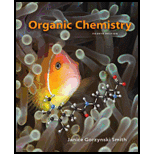
(a)
Interpretation: The product formed when the given compound is treated with
Concept introduction: The addition of
(b)
Interpretation: The product formed when the given compound is treated with
Concept introduction: The addition of
(c)
Interpretation: The product formed when the given compound is treated with
Concept introduction: The addition of
(d)
Interpretation: The product formed when the given compound is treated with
is to be predicted.
Concept introduction: In presence of sodium metal in ammonia, the is alkyne is reduced to
Want to see the full answer?
Check out a sample textbook solution
Chapter 12 Solutions
Organic Chemistry
- Reaction of 2-methylpropene with CH3OH in the presence of H2SO4 catalyst yieldsmethyl tert-butyl ether, CH3OC(CH3)3, by a mechanism analogous to that of acid- catalyzed alkene hydration. Write the mechanism, using curved arrows for each step.arrow_forwardDraw the organic products formed when cyclopentene is treated withfollowing reagent. (CH3)3COOH, Ti[OCH(CH3)2]4, (−)-DETarrow_forwardDraw the organic product(s) formed upon the addition of HBr to (a) 2-methyl-2-pentene, (b) trans-2-hexene, and (c) 4-methylcyclohexene. How many regioisomers can be formed in each case?arrow_forward
- Oximene and myrcene, two hydrocarbons isolated from alfalfa that have the molecular formula C10H16, both yield 2,6- dimethyloctane when treated with H2 and a Pd catalyst. Ozonolysis of oximene forms (CH3)2C = O, CH2 = O, CH2(CHO)2, and CH3COCHO. Ozonolysis of myrcene yields (CH3)2C = O, CH2 = O, (two equiv), and HCOCH2CH2COCHO. Identify the structures of oximene and myrcene.arrow_forward4. Compound A has the formula C 8H 8. It reacts rapidly with KMnO 4 to give CO 2 and a carboxylic acid, B (C 7H 6O 2), but reacts with only 1 molar equivalent of H 2 on catalytic hydrogenation over a palladium catalyst. On hydrogenation under conditions that reduce aromatic rings, 4, equivalents of H 2 are taken up and hydrocarbon C (C 8H 16) is produced. What are the structures of A, B, and C.arrow_forwardWrite an equation for the reaction of CH2=CHCH2CH3 with each of the following reagents: a. H2O, H+ b. KMnO4, OH- c. Oxygen (Combustion) Can you write it out please and thank youarrow_forward
- How would the reactant react with (CH2=CH)2CuLi ?arrow_forwardThe reagent NaBH4 acts as an ____ 1. H+ (hydride), 2. H- (hydride), 3. H+ (proton), 4. H- (proton) delivery agent. In a reaction with NaBH4 and methanol, the carbonyl (C=O) carbon atom of a ketonre is reduced or oxidized? to give 1. ether 2. alcohol 3. alkane 4. aldehyde 5. an ester product?arrow_forwardDraw the structure of the predominant form of CF3CH2OH (pK a = 12.4) at pH = 6.arrow_forward
- Draw the products formed when p-methylaniline (p-CH3C6H4NH2) is treated with each reagent. a. HCl b. CH3COCl c. (CH3CO)2O d. excess CH3I e. (CH3)2C = O f. CH3COCl, AlCl3 g. CH3CO2H h. NaNO2, HCl i. Part (b), then CH3COCl, AlCl j. CH3CHO, NaBH3CNarrow_forwardDraw the products formed when (CH3)2C=CH2 is treated with following reagent. [1] BH3; [2] H2O2, HO−arrow_forwardButanol is treated with H2SO4 and heat. Identify the reaction and give the product that can be formed from itarrow_forward
